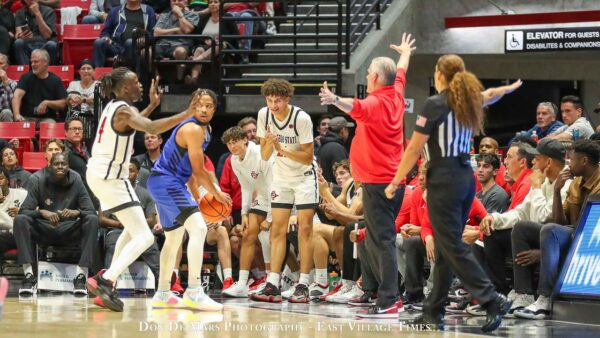SDSU Men’s Basketball Season Preview: Defense

BJ Davis dives for a lose ball. (Don De Mars/EVT)
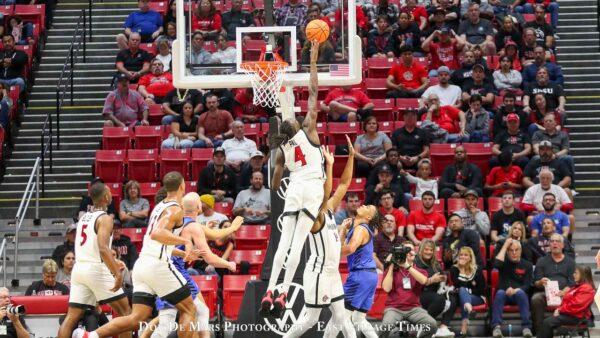
The Division I Era for men’s basketball at San Diego State began in the Fall of 1970. SDSU’s first ten years at the highest level went well. The Aztecs finished with a .524 winning percentage (142-129) in the 70s.
They fared much worse over the next 20 years. The 80s produced the first losing decade in program history with a 136-151 (.474) mark. From 1990-1999, the Aztecs barely reached 100 wins. Their 103-180 (.364) record in the 90s included a 43-121 (.262) conference tally.
Instead of Y2K, the turning of the millennium brought wins to The Mesa. During the 2000s, the Aztecs won 173 games against 140 defeats. The .553 winning percentage ranked first for any decade in the D1 era up to that point.
The next ten years produced even more excellence. In the 90s, the Aztecs barely topped the century mark in wins. SDSU did not lose 100 in the 2010s. They compiled a 256-93 record. Their .734 winning percentage passed the 1930s (127-58, .685) for the best decade in school history.
SDSU played 29 D1 seasons before hiring Steve Fisher to lead the program. He changed the program’s culture, emphasizing stifling defense over crowd-pleasing offense. Before Fisher/Dutcher, SDSU gave up fewer than 70 points per game in only four years (1981-82, 1982-83, 1989-90, 1994-1995). The last time a Fisher/Dutcher-led team gave up 70 points per game came in the 2004-2005 season.
Each of the past 18 seasons, the Aztecs have reached that defensive mark. Six times, they held the opposition under an average of 60 points per game, with a school record of 53.9 points in 2014-2015. Defense is the SDSU’s calling card and culture. They rode it to a national title game appearance last year.
SDSU Men’s Basketball Season Preview: Defense
The East Village Times’ first season preview detailed the offense for the 2023-2024 campaign. In this second article, EVT contributors Tron Johnson, Andre Haghverdian, and Paul Garrison aim at answering some of the key questions facing the Aztecs defense this upcoming season. Each question ends with a quote from an expert, SDSU Men’s Basketball assistant coach Dave Velasquez.
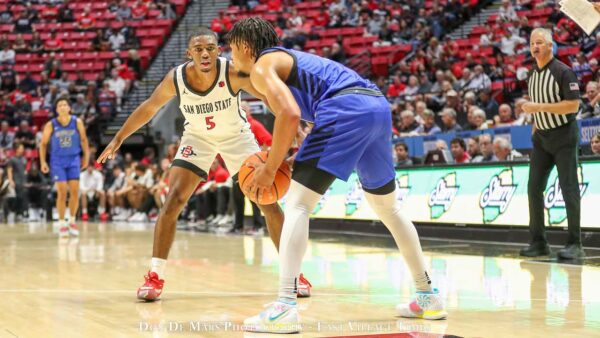
How will the defense look different this season?
Andre Haghverdian
Without defensive unicorns Nathan Mensah and Aguek Arop manning the five position and able to switch out and guard smaller players on the perimeter, the defense will have to play a bit differently. Look for more hedges and traps on ball screens and more defensive rotations to help against the other four offensive players on the court. The coaching staff and players have repeatedly mentioned taking more charges on drives to the basket, given less size and shot-blocking at the rim this season. Increased ball pressure and active hands in passing lanes for deflections on the perimeter will be paramount to keep open drives at a minimum and create turnovers.
Tron Johnson
There will be far fewer switches as Jaedon LeDee isn’t as mobile as Mensah was. The big man will be in a drop coverage or will occasionally hedge the ball screen. There will also be more ball pressure and aggressive help to try and force turnovers. The team took a step back in that regard last year, so look for them to try to increase it.
Paul Garrison
The defense will look different schematically because the Aztecs will need to help more on the ball than they did in years past. Beginning around the Arizona State game in 2020, SDSU began switching every ball screen regardless of position for nearly the entire game. They were able to do that because of Mensah’s unique skills. This year, they will hedge more instead of a straight switch. The defensive big will attack the ball handler more off a screen to allow time for the screened defender to get back on his original man.
David Velasquez
Well, it’s going to look a lot different, I’ll tell you that. … The defense is not going to look as long and athletic just to start. It’s not going to look as experienced. And those two things right there, it’s incredibly hard to replace.
It’s what every team in the country is trying to do is: become long and athletic and have older guys. We just happened to have it last year. So, it’s going to look different. It’s going to be a year that’s going to be fluid. We’re going to continue to get better. We’re not going to be at the beginning where we were at the end of last season. …
I don’t think it’s fair to even hold them to that bar, to that standard, when it starts. But eventually, it will get there, the same way it didn’t start for Micah Parrish and Darrion Trammell at the beginning of last year, and they both found a way to be one of our better defenders at the end of the year.
How will the defense look the same?
Andre Haghverdian
SDSU’s defense will always rely on a team mentality, with five guys “on a string” helping one another instead of individual, one-on-one defense. That will never change, regardless of the personnel. Protecting the paint will continue to be emphasized, although the manner in which it is done might look a little different. As always, a successful defensive possession has to end in securing the rebound off of a missed shot, and all five players must be conscious in that regard.
Tron Johnson
It will still be a pack line defense, where the emphasis is protecting the paint and helping on drives. The players will still be expected to move on the pass rather than the catch. Defensive rebounding will still be a priority. Aside from the amount of switching on ball screens, it should still look pretty similar to previous seasons.
Paul Garrison
One reason SDSU’s defense has been elite is the opposition can’t replicate the way Dutcher employs defenders. Typically, when players practice, they compete against others of similar size. The Aztecs utilize athletes in unorthodox positions. Point guards, for example, are accustomed to matching up against players below 6-foot-3 and above 6-foot-9. SDSU throws multiple players at them in between that range. The similarities between the defenses of the past and this season are the unique matchups they provide their opposition.
David Velasquez
Well, a lot of it’s just the emphasis on who we are. A lot of that, to me, has to do with what’s accepted, (and) what’s not accepted. … Our standard is not going to change in terms of how we coach them, but you’re still going to see every single time there’s a closeout, you’re still going to see high hands. You’re not going to see a lot of open lay-ups without somebody coming to try to fix it at the end. You’re not going to see a lot of wide-open shots with people looking around like what happened.
Just little things that we don’t accept here. It’s our identity. It’s how people identify San Diego State. And if you look at the banners and everything we’ve done here, it works. So, we’re not going to go away from the formula by any means.
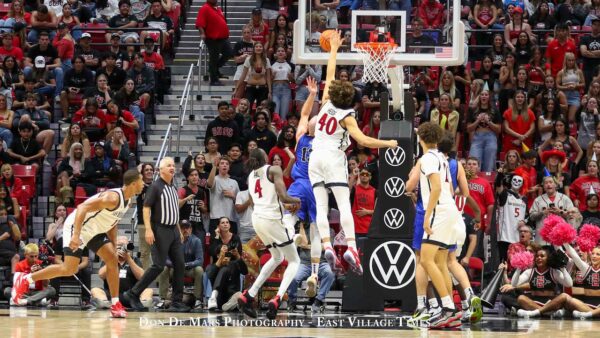
Will the Aztecs be able to switch all ball screens as frequently as they have the last three years?
Andre Haghverdian
I don’t believe they will as frequently for the reasons discussed above. It will not be fully scrapped, either. While LeDee’s ability to switch and guard on the perimeter is not as strong as his predecessors, he expressed confidence in it during my interview with him at a recent media availability, pointing to several instances late in the season last year where he was asked to do it and did it successfully. The emergence of Miles Heide at center could also give coach Dutcher more optimism and opportunity to employ it against specific opponents.
Tron Johnson
The short answer is no. To his credit, LeDee showed more aptitude at switching than was originally expected, and we haven’t seen what Heide can do yet, so maybe they surprise us. It seems unlikely, though. Mensah was a special player on that end, one that isn’t easily replicated. Asking LeDee to play like Mensah doesn’t help the team. So they’ll need to play in drop or hedge coverages more often.
Paul Garrison
In part of Velasquez’ comments not included in the article, he emphasized that Mensah could not switch all ball screens as a freshman. Even for an elite defender like Mensah, the technique took time to master.
The only combination of bigs with enough experience to use the tactic would be LeDee and Elijah Saunders. It is doubtful that Reese Waters, playing the four, or Heide, playing the five, have had enough time to learn how to play it. Demarshay Johnson, likewise, does not have the experience necessary even if he has been in the program longer. It would not be surprising to see SDSU wait until late in the second half to put its best defensive group capable of switching 1-5 into the contest to close out the game.
David Velasquez
We have guys that can still move their feet on the perimeter. … once the ball screen happens and once you switch it, we tell our guys this all the time, the magic in what we do in the switch five ball screens and all that kind of stuff, it’s not in the actual ball screen, and then guarding the guy one-on-one. That, for the most part, that’s the elementary part of it.
The magic in it is: okay, now who are you guarding? Are you guarding a shooter? (For) example, are you now on (Nevada guard) Jared Lucas, where you can’t give as much gap help, or maybe you’re on a guy like (Nevada forward) Trey Coleman, who you can be in the help a little bit longer and know that he’s going to be a driver first, but he can still shoot the ball, or you’re going to have to close out different.
Those little things are what made Nathan (Mensah) so good at the end. Where, no matter who he was able to switch to, he could … switch the scouting report, know he’s on this guy, know he can give this amount of gap help.
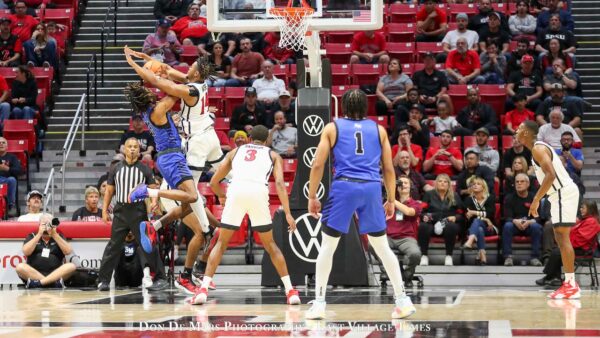
Can SDSU play four wings together and still rebound and defend as well as it has in seasons past?
Andre Haghverdian
The consistency shown by the team under this coaching staff would say yes, especially with the fact that most of college basketball, including the Mountain West Conference, plays small without true two-big lineups. To rebound effectively, they will need all five guys to help out in that regard, which may limit transition opportunities but is essential to complete a successful defensive possession. Micah Parrish, Waters, and Saunders have the length to be able to fight for rebounds alongside LeDee, an excellent rebounder.
Tron Johnson
This coaching staff has shown that they can build a good defense. In the six years with Coach Dutcher at the helm, five of the teams were ranked 30th or better on defense. The worst season was 2019, when they finished 78th, which is still well above average. So, expecting them to finish somewhere between 20th and 40th on defense is reasonable. They’ll also be able to rebound. LeDee is fantastic on the glass. He finished with almost twelve rebounds per 40 minutes last season. Jay Pal and Parrish are both sneaky good rebounders. Saunders and Heide are less proven but more than capable.
Paul Garrison
Playing four wings is among Dutcher’s preferred methods, but this season’s team will not have the ability to play small and still compete on the glass. Aztec great Matt Mitchell remains the only true wing to play extensive minutes at power forward. That Parrish and Waters are best utilized outside is not a knock on them; it is a reminder that Mitchell’s ability to play out of position and still dominate made him special.
Dutcher will give Parrish and Waters every opportunity to learn how to play the position early in the season because it would give SDSU an amazing offense. Ultimately, though, unless Dutcher is willing to sacrifice defense and rebounding for better offense, it will be used as a change of pace and not the primary way the Aztecs lineup.
David Velasquez
Well, we better because Coach Dutcher is not going to play you if you can’t, to be honest. Our identity, our formula for winning, is defending and rebounding. It’s something that we truly believe in, and we are going to find a way to get it done. We’ve had a lot of years where guys had to just kind of adapt into new roles.
As a coach, you never feel like you have all the answers, and every team’s a little different. So yeah, we might have some different ball screen coverages this year. Yeah, we might have some different kinds of rotational rebounding things you might do differently that we’re experimenting with right now because not every team’s the same, not all the personnel is always the same. So yeah, I do feel like we have a team that could still be really good at defending and rebounding.
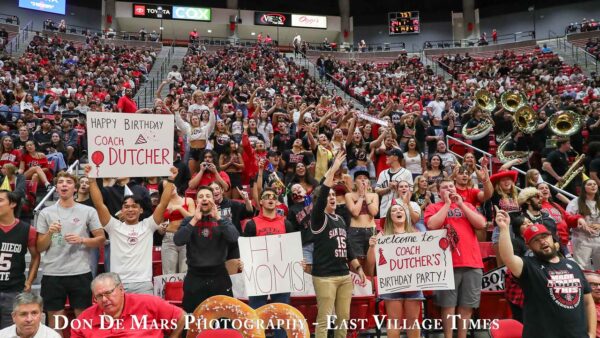
Which player will see more time solely because of how they play defense?
Andre Haghverdian
The biggest question mark for the rotation heading into the season is who will be the ninth man/backup center, assuming LeDee starts at center. The two men battling for that spot are redshirt sophomore Demarshay Johnson and true freshman Miles Heide. It’s obvious that the person who shows more aptitude on the defensive end of the court with earn that ninth rotation spot.
While Johnson has two years of experience in the program ahead of Heide, I would give the freshman the edge from what has been seen and heard from the preseason. His ability to move his feet, show active hands, and dive for loose balls will earn him playing time and endear him to the Viejas Arena faithful.
Tron Johnson
Miles Byrd seems like the obvious answer. He is long and athletic and showed defensive flashes last year in limited time. He has the ability to really hound ball handlers and jump passing lanes, which will both be emphasized this year.
Paul Garrison
Following the exhibition on Monday, Saunders spoke about his focus on the defensive end. The coaches, he said, have challenged him to fill the void left by Arop and Keshad Johnson. Saunders practiced with the rotation players a year ago, so he is well-versed in everything the Aztecs like to do. As the season wears on, Saunders is the player who will earn time because of how plays defense.
David Velasquez
A guy that is really showing (because) he’s getting so much better defensively is Miles Byrd. Miles, it’s funny; right now, he’s actually leading our team in blocked shots at practice. He’s long, he’s athletic. He’s one of those guys he kind of blocks shots like Arop and Keshad did last year where you’re two, three spots away, but you’re so long and athletic, you just come over and get it at the rim. You almost come out of nowhere. You know it’s not necessarily your help.
And then his length to be able to guard on the perimeter where it’s really hard to shoot a step back or a pull up on him ’cause he’s long enough to block the shot.
My earliest sport’s memory involve tailgating at the Murph, running down the circular exit ramps, and seeing the Padres, Chargers and Aztecs play. As a second generation Aztec, I am passionate about all things SDSU. Other interests include raising my four children, being a great husband and teaching high school.
